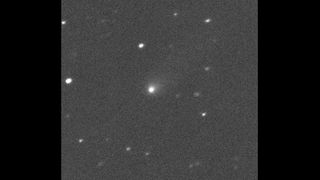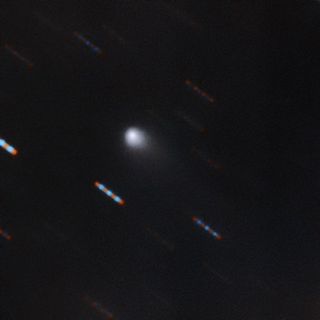Interstellar Comet: Here's Why It's Got Scientists So Pumped Up

Karen Meech wouldn't credit Comet C/2019 Q4 with good timing. But when an astronomer has a chance to study the first known interstellar comet, by golly they take it, unfinished paper for a major conference aside.
Meech is just one of the astronomers who has rushed to ask for time using instruments on Earth and in its orbit to study a major cosmic celebrity: a bright, fuzzy dot in the sky that she and her colleagues are confident is the first interstellar comet known to scientists and just the second interstellar object at all, following 2017's blockbuster discovery of a strange space rock eventually named 'Oumuamua. But to Meech, this new discovery is perhaps a more exciting opportunity.
"This one is spectacular compared to the first one, where we had effectively a week to observe it," Meech told Space.com. The astronomer at the University of Hawaii, who made critical observations of 'Oumuamua, said, "So you had to write your proposals, observe it, get the observations down, reduce the data, and we managed to pull together a paper in a week. But this one, we have the luxury of lots of time."
Related: 1st Color Photo of Interstellar Comet Reveals Its Fuzzy Tail
For C/2019 Q4, the clock started early in the morning of Aug. 30, when a Crimean astronomer named Gennady Borisov trained a small telescope near the horizon, closer to the sun than many scientific instruments can point.
That's perhaps the first great irony of the eagerly awaited interstellar object: Scientists' organized surveys searching the skies for such an object wouldn't have spotted the object nearly as quickly, Meech said, since they don't examine the sky so close to the sun. Because the horizon is particularly clouded by atmospheric interference, these surveys prioritize areas they can see more clearly.
Many of scientists' favorite instruments aren't even physically capable of seeing the object right now. "With small telescopes, you can point as close to the horizon as you wish, and so anyone that has that sort of telescope can easily observe it now," Meech said. "The really big telescopes that you would want to use to do the science have pretty significant limits to how close to the horizon they point, so many of the big ones can't get to it until mid to late October."
Get the Space.com Newsletter
Breaking space news, the latest updates on rocket launches, skywatching events and more!
(Telescopes in the Northern Hemisphere will be able to study the comet until January, when Southern Hemisphere instruments will take over the task. By October 2020, Meech calculated, it will be nearly impossible to spot, speeding past the sun on its way to visiting a new world.)
But Borisov was able to spot the comet on Aug. 30, and he posted news of the sighting on an astronomy forum. As his and others' observations came in, calculations suggested that its orbit might arc across our solar system, not loop endlessly through it, prompting "cautious interest" among scientists, Meech said.

And the rush began. Meech and her colleagues caught C/2019 Q4 on the nights of Sept. 8 to 10 using the Canada-France-Hawaii Telescope on Mauna Kea in Hawaii. By Sept. 11, the Minor Planet Center, which monitors these things, was willing to conclude that data suggested that the object likely came from beyond our solar system. If it confirms the preliminary conclusion, the object's name will be adjusted to begin with 2I, marking the second interstellar object discovered. "But our team internally is 100% convinced," Meech said.
Meech and her colleagues are also confident it really is a comet, unlike 'Oumuamua, which faced an early identity crisis. Astronomers had expected to see a comet first because, if the objects are equal sizes and equal distances from the sun, a comet will appear much brighter than an asteroid.
"To find the first one not to have a tail, when it's really hard to see, had some pretty interesting implications," Meech said. "It meant, wow, there must be a lot more of these [interstellar objects] than we had anticipated, by maybe a factor of 100."
But now that they do have a comet — and one they can watch for more than a year, no less — scientists are thrilled. When 'Oumuamua sped past, astronomers focused on its strange, elongated shape.
That was in part because they couldn't see any gas or dust that they could study to understand what the object was made of, Meech said. But the new interstellar comet is cocooned in gunk that telescopes can analyze. Their results will tell scientists whether the comet's home solar system matches ours in terms of whether the proportion of different chemicals follows the same basic recipe.
Astronomers are beginning to be able to analyze that proportion in other solar systems, but it's perhaps the equivalent of trying to reconstruct the precise taste of a well-spiced curry based on a friend's description of a long-ago meal.
"We go back in time to look at what happened in our early solar system by looking at the leftover bits and pieces — the comets and the asteroids — and try to put everything back together," Meech said. "Now, conveniently, we've been handed a couple of objects now that had been ejected from those disks that we can study close up like we do in our solar system, so that's really neat."
If the comet's recipe turns out to be different from our solar system's, the chemical analysis could be the single most significant research scientists conduct on the visitor, she said. But there are plenty of other, more basic questions to ask as well.
Like, how big is it? Meech and her colleagues saw the comet's tail stretching 93,000 miles (150,000 kilometers) into space. But it's much more difficult to estimate the size of the comet itself under all that fuzz enveloping it. The team has made a preliminary estimate that the object is between 1.2 and 10 miles (2 and 16 km) across.
That calculation relies on estimating the brightness of the comet in one image compared with the sky around it. Then Meech applied a model built on several assumptions, such as the idea that the comet reflects the same percent of light as our local comets do. Any one of those premises could turn out to be incorrect as scientists learn more about the object.
"You would normally never publish something fitting a complex model to a single data point — that's crazy," she said. But Meech — and many of her colleagues — all need something to tell the people in charge of the host of instruments they want to commandeer to study the interstellar comet in order to begin answering all these questions.
"Everybody's been scrambling to write proposals," Meech said. And thank goodness. "We've milked the one data point to death."
- 'Oumuamua: The Solar System's 1st Interstellar Visitor Explained in Photos
- Photos: Spectacular Comet Views from Earth and Space
- Wow! 1st Interstellar Asteroid Is a Spinning Space Cigar
Email Meghan Bartels at mbartels@space.com or follow her @meghanbartels. Follow us on Twitter @Spacedotcom and on Facebook.
Join our Space Forums to keep talking space on the latest missions, night sky and more! And if you have a news tip, correction or comment, let us know at: community@space.com.

Meghan is a senior writer at Space.com and has more than five years' experience as a science journalist based in New York City. She joined Space.com in July 2018, with previous writing published in outlets including Newsweek and Audubon. Meghan earned an MA in science journalism from New York University and a BA in classics from Georgetown University, and in her free time she enjoys reading and visiting museums. Follow her on Twitter at @meghanbartels.
